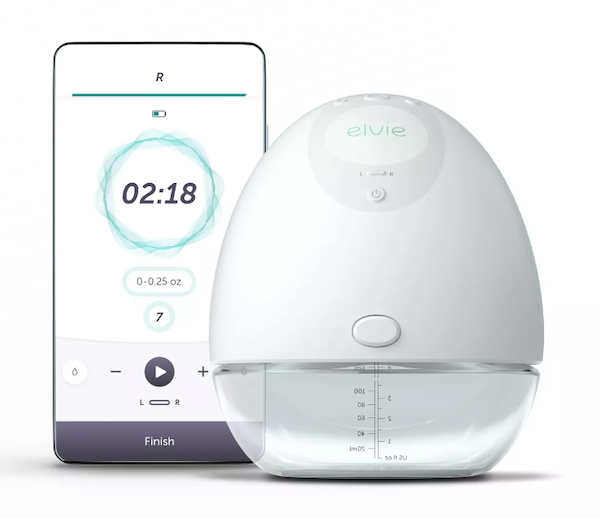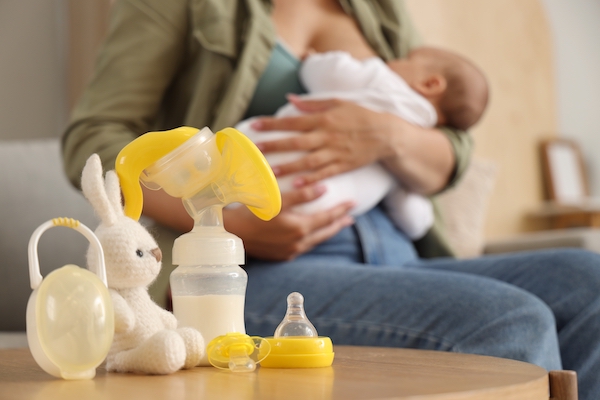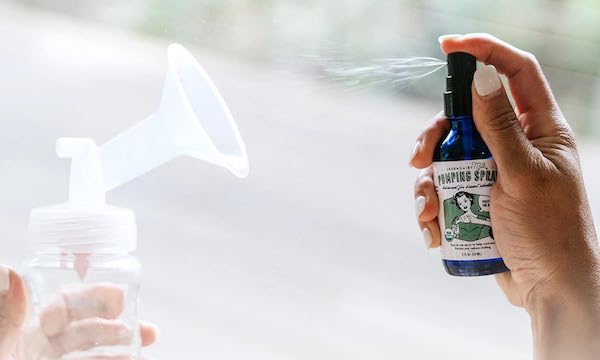It is beyond amazing how, even after carrying them for 9 months, we as moms continue to connect with our babies in such a magical way, by feeding them. Before I get ahead of myself, I do want to point out that feeding your baby can and does look different for every mom. Whether you choose to breastfeed, pump, or use formula, what matters most is a baby that’s happy and healthy. This post is, however, specifically written for our breast milk mommas: what to know and how to better their pumping skills.
I never really thought too much about pumping when I was pregnant, mainly because I just assumed breastfeeding would be straightforward: my milk would come in, the baby would latch, and most of our feedings would be seamless. My only goal with pumping was to build a “freezer stash” for times I wouldn’t be with the baby during her wake window.
But, like most things in the postpartum stage, my milk journey was not so simple. My little one would get colic in the evenings so badly that it made breastfeeding almost impossible. My goal of giving breastmilk to her for a year started to feel like an insurmountable task. The game changer: incorporating pumping into my day-to-day routine. With the help of about four different pumps and many mistakes along the way, I made it to my year goal! So let me share 6 tips on how to not just survive but thrive as a pumping mom!
Tip #1: Selecting the right pump for you

One huge mistake I made in the beginning was using the wrong pump for months. The pump I used was the Elvie Electric, which is a fantastic pump for on-the-go. However, if you are pumping more than once a day, you need a proper primary pump. What does this mean? While this wearable pump is super discreet, convenient, and easy to use, it will not empty the breast the way a primary pump can. Why is that so important? Breast milk works on a supply-and-demand basis. In order to keep up with what your baby needs, the pump has to get as much out of you as your baby would, and they empty the breast every time they feed. So, while a wearable pump is discreet, it just isn’t as efficient as a primary one. Unfortunately, after three months of using this pump, I started to see a drop in my supply, and I didn’t know why until I made the switch. Again, the Elvie is a great secondary pump for when you are on the go, but I recommend having a heavy-duty pump at home for daily use!

What is a good primary pump? Well, there are actually a few I can recommend that work great! The tried and true is the Spectra – S1 Plus Electric Breast Milk Pump. You can’t go wrong with this one, which features comfortable suction pump levels that mimic natural breastfeeding as closely as possible. It is also one of the only pumps that have a vibration pattern that helps with your let-down. Another classic option is the Medela Pump in Style Breast Pump. Do check with your insurance to see if you qualify for any coverage for a pump, as most do these days, and it can help you save tons!
Tip #2: Flange size

Now that you have a good pump, make sure to get the correct size flange. One too small or too big cannot only be painful but can also tank your supply. If you are unsure of your size, check out the Breast Pump Flange Fit Guide by Babylist. There are tons of helpful tips and information about pumps and flange types that will really make all the difference.
Tip #3: Use a pumping spray

If pregnancy and birth teach us anything, it’s that women are tough. We can endure pain and do whatever it takes to take care of our babies. But when it comes to pumping, pain shouldn’t be part of the process. Slight tugging is normal, but if it hurts or pinches, something is wrong. Don’t do what I did: I powered through and assumed it was normal for pumping to hurt! But there are steps you can take to ensure a pain-free pumping session. First, check the size of your flange. If it still hurts for the first couple minutes of each session, try this pumping spray. It can help sore nipples and even clogged ducts by acting as an organic lubricant.
Tip #4: Stick to a consistent schedule

Whether you are pumping for a freezer stash, to replace a bottle given, or just to increase supply, be consistent in the schedule that works best for you and your baby. If you’re a fully pumping mom or pumping at work to replace feedings you’re missing, try to pump on the same schedule as your baby’s feedings so you keep your milk supply going strong and aligned with your baby’s demand. This will usually look like every three to four hours. If you’re just trying to build up your milk supply, try to pump between your baby’s first and second feed in the morning after his or her longest stretch of sleep. You will have the most milk at the beginning of the day. Aim to spend 15 to 20 minutes hooked up to the pump in order to empty the breast (some women will need 30 minutes or more with the pump, especially in the early days). Emptying the breast completely is key. Pump until the milk starts slowing down and your breasts feel well-drained. Most women can have more than one let-down per session, so play around with your device and switch back and forth between stimulation and letdown mode.
Tip #5 Eat and Drink Consistently

Now this particular tip may seem obvious. However, once the baby arrives, you may become so focused on their feeding schedule that you forget to think about yours! One thing I absolutely loved was lactation cookies. Not only were they absolutely scrumptious, they were easy to make and loaded with great ingredients for your body to make milk. Another great way to get your calories in is a lacation smoothie. My husband made this for me almost every morning, and as a bonus, he really liked it too. I do have two tips when it comes to hydration. First, get a cup you absolutely love that holds at least 32 ounces of water. To make it easy, find one like this Owala bottle that has a handle and comes in many cute color options. The next thing to up your hydration would be adding in a supplement like the Liquid IV to help with optimal absorption of the water you do drink.
Tip #6: Make pumping peaceful

This has to be the most difficult piece of advice I can give. I would be lying if I said I mastered this one myself. Being your baby’s only source of food and taking care of them as well as yourself is overwhelming, to say the least. Try to time your pumping sessions during naps or when someone can watch your little one. Escape to a quiet, peaceful space if possible. Put on a good podcast or TV show, or pick up a good book. Maybe even take this time to watch sweet videos of your little one on your phone, which has actually been proven to help with your let-down. Do NOT, however, watch the bottle as it fills. If you have to, put socks over the bottles while you pump. Stressing over each ounce can actually be the reason your supply is decreasing as well. Take this 15 to 30 minutes to remind yourself of all the good you are doing for your baby on a daily basis. Even if you, like me, made a long term goal for yourself, you only need to do one day at a time. You got this momma!

